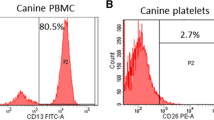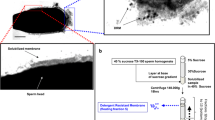Abstract
Prostasomes are membranous vesicles present in ejaculated human semen. They are very rich in cholesterol and can interact with spermatozoa. Their physiological roles are still under study. Prostasomes were mixed with liposomes prepared from various lipids, such as N-[1-(2,3-dioleoyloxy)propyl]-N,N,N-trimethylammonium (DOTAP), DOTAP/1,2-dipalmytoyl-sn-glycero-3-phosphorylcholine (DPPC, 4:1 molar ratio) and DOTAP/cholesterol (4:1, molar ratio) at different pH values (5–8). The mixing of the lipid phases (fusion) was determined by the relief of octadecyl rhodamine B chloride (R18) self-quenching and the radii of the vesicles, by light scattering measurements. The mixing of lipids and the radii of prostasomes were both influenced by the addition of liposome, although in a different manner. The ability of prostasomes (modified by previous treatment with liposomes) to transfer lipid to spermatozoa was also measured. Pretreatment with DOTAP decreased the phenomenon and addition of DPPC abolished it. On the other hand, pretreatment of prostasomes with DOTAP/cholesterol liposomes did not affect the transfer of lipid between prostasome and spermatozoa. Therefore, the ability of vesicles to fuse (or, at least, to exchange the lipid component) was affected by the enrichment in either natural or artificial lipid. This may open new possibilities for the modulation of spermatozoa capacitation and acrosome reaction.






Similar content being viewed by others
References
Arienti G., Carlini E., Palmerini C.A. 1997a. Fusion of human sperm to prostasomes at acidic pH. J. Membr. Biol. 155:89–94
Arienti G., Carlini E., Saccardi C., et al. 2002. Nitric oxide and fusion with prostasomes increase cytosolic calcium in progesterone-stimulated sperm. Arch. Biochem. Biophys. 402:255–258
Arienti G., Carlini E., Verdacchi R., et al. 1997b. Prostasome to sperm transfer of CD13/aminopeptidase N (EC 3.4.11.2). Biochim. Biophys. Acta. 1336:533–538
Arienti G., Carlini E., Verdacchi R., et al. 1997c. Transfer of aminopeptidase activity from prostasomes to sperm. Biochim. Biophys. Acta. 1336:269–274
Arienti G., Nicolucci A., Santi F., et al. 2001. Progesterone-induced increase of sperm cytosolic calcium is enhanced by previous fusion of spermatozoa to prostasomes. Cell Calcium 30:222–227
Arienti G., Polci A., Carlini E., et al. 1997d. Transfer of CD26/dipeptidyl peptidase IV (E.C. 3.5.4.4) from prostasomes to sperm. FEBS Lett. 410:343–346
Arrastua L., San SE., Quincoces AF., et al. 2003. In vitro fusion between Saccharomyces cerevisiae secretory vesicles and cytoplasmic-side-out plasma membrane vesicles. Biochem. J. 370:641–649
Arvidson G., Ronquist G., Wikander G., et al. 1989. Human prostasome membranes exhibit very high cholesterol/phospholipid ratios yielding high molecular ordering. Biochim. Biophys. Acta. 984:167–173
Bartlett G.R. 1959. Phosphorus assay in column chromatography. J. Biol. Chem. 234:466–468
Bordi F., Cametti C., De Luca F., et al. 2001. Hydrodynamic radii and lipid transfer in prostasome self-fusion. Arch. Biochem. Biophys. 396:10–15
Campbell R.B., Balasubramanian S.V.,Straubinger R. 2001. Phospholipid-cationic lipid interactions: influences on membrane and vesicle properties. Biochim. Biophys. Acta. 1512:27–39
Corazzi L., Fratto G., Pistolesi R., et al. 1989. Fusion of liposomes and rat brain microsomes examined by two assays. J. Membr. Biol. 112:123–129
Corazzi L., Pistolesi R., Arienti G. 1991. The fusion of liposomes to rat brain microsomal membranes regulates phosphatidylserine synthesis. J. Neurochem. 56:207–212
Crommelin D.J.A., Schreirer H. 1994. Liposomes. In: J Kreuter (ed) Colloidal Drug Delivery Systems, Maecell Dekker, Inc., New York .pp. 73–190
Duzgunes N., Nir S. 1999. Mechanisms and kinetics of liposome-cell interactions. Adv. Drug Deliv. Rev. 40:3–18
Duzgunes N. 1988. Cholesterol and membrane fusion. In: PL Yeagle (ed) Biology of cholesterl. CRC Press, Boca Raton, pp. 197–212
Duzgunes N., Wilschut J. 1993. Fusion assays monitoring intermixing of aqueous contents. Methods Enzymol. 220:3–14
Fabiani R. 1994. Functional and biochemical characteristics of human prostasomes. Minireview based on a doctoral thesis. Ups. J. Med. Sci. 99:73–111
Fabiani R., Johansson L., Lundkvist O., et al. 1994. Promotive effect by prostasomes on normal human spermatozoa exhibiting no forward motility due to buffer washings. Eur. J. Obstet. Gynecol. Reprod. Biol. 57:181–188
Hoekstra D., de Boer T., Klappe K., et al. 1984. Fluorescent method for measuring the kinetic of fusion between biological membranes. Biochemistry 23:5675–5681
Hoekstra D., Duzgunes N. 1993. Lipid mixing assays to determine fusion in liposome systems. Methods Enzymol. 220:15–32
Kelly R.W., Holland P., Skibinski G., et al. 1991. Extracellular organelles (prostasomes) are immunosuppressive components of human semen. Clin. Exp. Immunol. 86:550–556
Lilja H., Laurel C.B. 1984. Liquefaction of coagulated human semen. Scand. J. Clin. Lab. Invest. 44:447–452
Lopata A., Patullo M.G., Chang A., et al. 1976. A method for collecting motile spermatozoa from human semen. Fertil. Steril. 27:265–275
Palmerini C.A., Carlini E., Nicolucci A., et al. 1999. Increase of human spermatozoa intracellular Ca2+ concentration after fusion with prostasomes. Cell Calcium 25:291–296
Palmerini C.A., Saccardi C., Carlini E., et al. 2003. Fusion of prostasomes to human spermatozoa stimulates the acrosome reaction. Fertil. Steril. 80:1–4
Ronquist G., Brody I. 1985. The prostasome: its secretion and function in man. Biochim. Biophys. Acta. 822:203–218
Rudel L.L., Morris M.D. 1973. Determination of cholesterol using o-phtalaldehyde. J. Lipid Res. 14:364–366
Schmitz, K.S. 1990. Introduction to quasi elastic light scattering by macromolecules. Academic Press, New York
Senior J.H., Trimble K.R., Maskiewicz R. 1991. Interaction of positively-charged liposomes with blood: implications for their application in vivo. Biochim. Biophys. Acta. 1070:173–179
Skibinski G., Kelly R.W., Harkiss D., et al. 1992. Immunosuppression by human seminal plasma–extracellular organelles (prostasomes) modulate activity of phagocytic cells. Am. J. Reprod. Immunol. 28:97–103
Stegmayr B., Ronquist G. 1982. Promotive effect on human sperm progressive motility by prostasomes. Urol. Res. 10:253–257
Zhao L., Feng S.S. 2004. Effects of lipid chain length on molecular interactions between paclitaxel and phospholipid within model biomembranes. J. Colloid. Interface Sci. 274:55–68
Author information
Authors and Affiliations
Corresponding author
Rights and permissions
About this article
Cite this article
Palmerini, C.A., Cametti, C., Sennato, S. et al. Role of Cholesterol, DOTAP, and DPPC in Prostasome/Spermatozoa Interaction and Fusion. J Membrane Biol 211, 185–190 (2006). https://doi.org/10.1007/s00232-006-0009-2
Received:
Revised:
Published:
Issue Date:
DOI: https://doi.org/10.1007/s00232-006-0009-2




